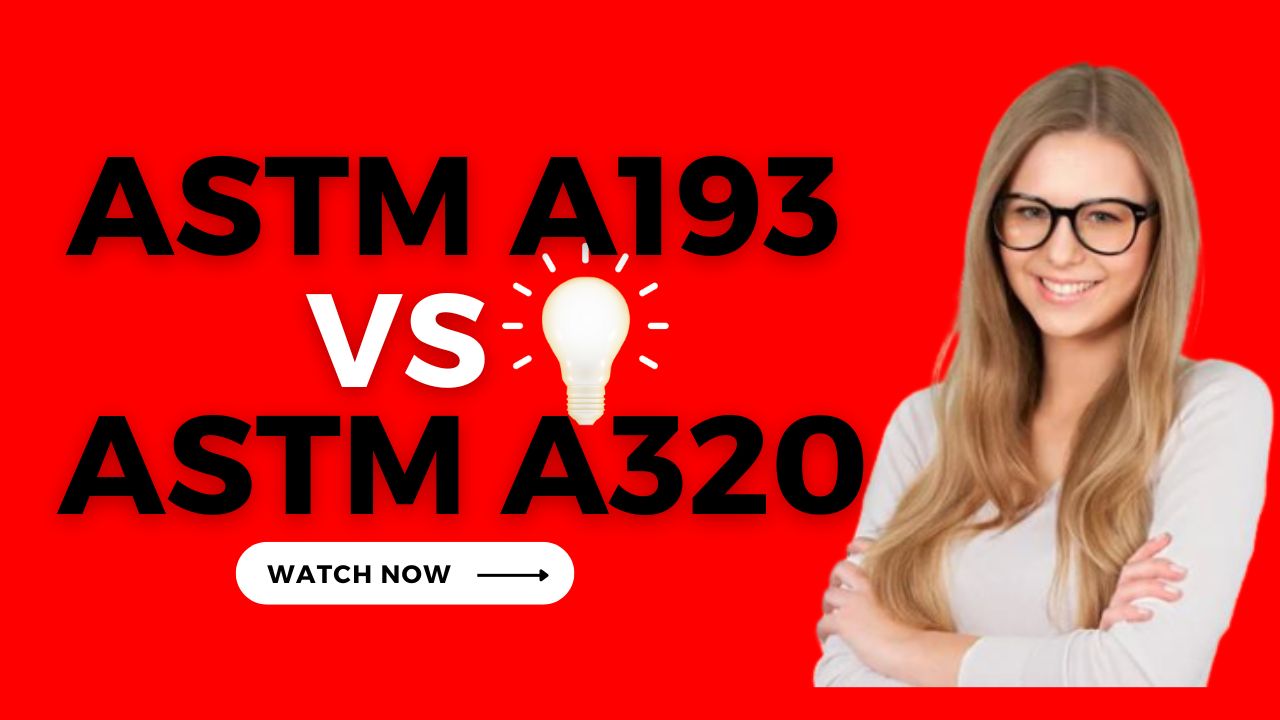Introduction
When it comes to bolting materials, precision and reliability are paramount for ASTM A193 vs ASTM A320. The choice between ASTM A193 and ASTM A320 standards can significantly influence the performance and safety of various applications. In this comprehensive guide, we’ll delve into the intricate differences between ASTM A193 and ASTM A320, shedding light on their specific applications, materials, and benefits.
Table of Contents
Do not miss the detailed course 7 Modules of Piping Codes & Standards
Enrollment link
Check out the Similar Articles on ASTM Standards
ASTM A193 and ASTM A320 are two essential standards that define the quality and performance requirements for fasteners used in a wide range of industries. Understanding the differences between these standards is crucial when selecting fasteners for specific applications.
The Importance of Quality Fasteners
Fasteners, such as bolts, screws, and studs, are integral components in various industries, including construction, manufacturing, and infrastructure. They play a critical role in ensuring the structural integrity and safety of assemblies and structures.
Role of ASTM Standards
ASTM standards provide clear guidelines for the design, manufacturing, and testing of fasteners, ensuring they meet stringent quality and performance criteria.
ASTM A193
Standard Specification for Alloy-Steel and Stainless Steel Bolting for High Temperature or High-Pressure Service and Other Special Purpose Applications
ASTM A193 is a widely used standard that covers alloy steel and stainless steel bolting materials for high-temperature or high-pressure service and other specialized applications.
ASTM A193 Grades
- B5: Alloy steel suitable for use in low-temperature applications.
- B7: Alloy steel commonly used in high-temperature and high-pressure service.
- B8: Stainless steel suitable for general corrosive service.
- B8M: Stainless steel with improved corrosion resistance, ideal for marine and chemical environments.
Mechanical Properties of ASTM A193 Grades
| Property | B5 | B7 | B8 | B8M |
|---|---|---|---|---|
| Tensile Strength (psi) | 105,000 min | 125,000 min | 75,000 min | 75,000 min |
| Yield Strength (psi) | 85,000 min | 105,000 min | 30,000 min | 30,000 min |
| Elongation (%) | 16% min | 16% min | 30% min | 30% min |
| Reduction of Area (%) | 50% min | 50% min | 50% min | 50% min |
Testing Requirements
ASTM A193 specifies various testing requirements, including mechanical testing, hardness testing, and impact testing, to ensure the fasteners’ reliability and performance.
ASTM A320
Standard Specification for Alloy-Steel and Stainless Steel Bolting for Low-Temperature Service
ASTM A320 is a standard that covers alloy steel and stainless steel bolting materials specifically designed for low-temperature service.
ASTM A320 Grades
- L7: Alloy steel suitable for low-temperature service.
- L7M: Alloy steel with improved toughness at low temperatures.
- B8: Stainless steel suitable for general corrosive service at low temperatures.
- B8M: Stainless steel with improved corrosion resistance for low-temperature applications.
Mechanical Properties of ASTM A320 Grades
| Property | L7 | L7M | B8 | B8M |
|---|---|---|---|---|
| Tensile Strength (psi) | 125,000 min | 125,000 min | 75,000 min | 75,000 min |
| Yield Strength (psi) | 105,000 min | 105,000 min | 30,000 min | 30,000 min |
| Elongation (%) | 16% min | 16% min | 30% min | 30% min |
| Reduction of Area (%) | 50% min | 50% min | 50% min | 50% min |
Testing Requirements
ASTM A320 also specifies various testing requirements, including mechanical testing, hardness testing, and impact testing, to ensure the reliability and performance of the fasteners in low-temperature environments.
Differences Between ASTM A193 and ASTM A320
While both ASTM A193 and ASTM A320 cover bolting materials, they are designed for different temperature ranges and applications. Here are the key differences:
| Difference | ASTM A193 | ASTM A320 |
|---|---|---|
| Temperature Range | High-temperature and high-pressure applications, including specialized uses. | Low-temperature applications. |
| Grades Available | Includes B5, B7, B8, B8M for various service conditions. | Includes L7, L7M, B8, B8M specifically for low-temperature service. |
| Application Focus | Suitable for a wide range of applications, including high-temperature and high-pressure environments. | Designed for applications where low temperatures are a concern, such as cryogenic or cold storage systems. |
Quality Control & Testing
Both ASTM A193 and ASTM A320 require stringent quality control measures to ensure the fasteners’ compliance with specifications. Key aspects of quality control include:
| Quality Control Measure | ASTM A193 | ASTM A320 |
|---|---|---|
| Chemical Analysis | Rigorous chemical analysis to verify the elemental composition. | Rigorous chemical analysis to verify the elemental composition. |
| Mechanical Testing | Mechanical testing, including tensile and yield strength tests. | Mechanical testing, including tensile and yield strength tests. |
| Hardness Testing | Hardness testing to assess the material’s hardness properties. | Hardness testing to assess the material’s hardness properties. |
| Impact Testing | Impact testing to evaluate the material’s toughness at specified temperatures. | Impact testing to evaluate the material’s toughness at specified low temperatures. |
ASTM A193 vs ASTM A320: An In-depth Comparison
ASTM A193vs ASTM A320: Understanding the Basics
Both ASTM A193 and ASTM A320 are specifications for high-strength bolting materials, but they have distinct applications. ASTM A193 is designed for use in high-temperature and high-pressure environments, making it suitable for industries such as petroleum, chemical, and power generation. On the other hand, ASTM A320 is tailored for low-temperature services, including cryogenic applications in industries like liquefied natural gas (LNG) and refrigeration.
Don’t miss the Complete Course on Piping Engineering: Check Now
By EPCLand.com
Materials and Grades: ASTM A193 vs ASTM A320
ASTM A193 includes various grades such as B7, B8, B8M, and more. These grades are made from alloy steels and stainless steels, offering excellent mechanical properties and corrosion resistance. In contrast, ASTM A320 encompasses grades L7, L43, B8, and others, which are specifically designed to perform well in low-temperature conditions. The choice of materials and grades depends on the intended application and the environmental conditions they will be exposed to.
Applications and Industries
- ASTM A193 Applications: Industries requiring bolting materials to withstand high temperatures and pressures benefit from ASTM A193. This includes applications in boilers, heat exchangers, and pressure vessels.
- ASTM A320 Applications: On the other hand, ASTM A320 finds its use in low-temperature environments. Industries like LNG, cryogenic storage, and refrigeration rely on its performance in extreme cold conditions.
Strength and Performance
- ASTM A193 Strength: Bolting materials under ASTM A193 are known for their high tensile strength, making them suitable for applications where load-bearing capacity is critical.
- ASTM A320 Strength: ASTM A320 materials exhibit lower tensile strength than their A193 counterparts. However, they offer excellent toughness and resilience at low temperatures.
Corrosion Resistance
- ASTM A193 Corrosion Resistance: With a focus on high-temperature environments, ASTM A193 materials are designed to resist corrosion and oxidation at elevated temperatures.
- ASTM A320 Corrosion Resistance: ASTM A320 materials prioritize corrosion resistance in low-temperature settings, ensuring they remain effective even in extreme cold conditions.
Compatibility and Interchangeability
Both ASTM A193 and ASTM A320 materials are not interchangeable due to their distinct properties and intended applications. Using the wrong material can compromise the safety and reliability of the bolting components in various systems.
Certifications and Compliance
When sourcing bolting materials, it’s crucial to ensure that they meet the required standards and certifications. Manufacturers of ASTM A193 and ASTM A320 materials must adhere to specific guidelines to ensure the quality and performance of their products.
Do not miss the detailed course 7 Modules of Piping Codes & Standards
Enrollment link
FAQs about ASTM A193 vs ASTM A320
Q: Can ASTM A193 materials be used in low-temperature applications? A: No, ASTM A193 materials are not designed for low-temperature services as they may become brittle and fail under extreme cold conditions.
Q: What is the primary difference between ASTM A193 and ASTM A320? A: The key distinction lies in their application areas. ASTM A193 is for high-temperature and high-pressure environments, while ASTM A320 is for low-temperature services.
Q: Are there any alternatives to ASTM A193 and ASTM A320 materials? A: Yes, depending on the specific requirements of the application, other standards such as ASTM F1554 and ASTM A449 might be suitable alternatives.
Q: Can ASTM A320 materials be used in high-temperature applications? A: While ASTM A320 materials are primarily designed for low-temperature services, their mechanical properties might not hold up well at elevated temperatures.
Q: What industries commonly use ASTM A320 materials? A: ASTM A320 materials find widespread use in industries involving cryogenic storage, LNG, and refrigeration.
Q: Are there cases where materials from both standards are used together? A: Yes, in certain scenarios, hybrid assemblies involving materials from both standards might be used to address specific temperature gradients within a system.
Conclusion
The choice between ASTM A193 and ASTM A320 is pivotal in ensuring the safety, reliability, and performance of bolting materials across various industries. While ASTM A193 is tailored for high-temperature and high-pressure environments, ASTM A320 excels in low-temperature applications. Understanding their distinct characteristics empowers engineers and manufacturers to make informed decisions, ultimately contributing to the success of critical projects.
Recommended courses (Published on EPCLand):
- Basics of Piping Engineering
- Piping Layout Engineering
- Piping Material Engineering
- Piping Stress Analysis
- Complete Course on Piping Engineering
- Material Requisitions
- Piping Material Specifications
- Valve Material Specifications
Related Video
Attempt Quiz
Question 1:
What do ASTM A193 and ASTM A320 standards cover?
Explanation: ASTM A193 covers fasteners (bolts, studs, etc.) for high-temperature, high-pressure applications, while ASTM A320 covers steel bolting materials for low-temperature service.
Question 2:
Which type of steel materials are covered by ASTM A193 and ASTM A320, respectively?
Explanation: ASTM A193 covers carbon and alloy steel materials, while ASTM A320 covers steel materials for low-temperature service, including carbon and alloy steels.
Question 3:
What is the primary difference between ASTM A193 Grade B7 and ASTM A320 Grade L7?
Explanation: The primary difference between ASTM A193 Grade B7 and ASTM A320 Grade L7 lies in their intended service conditions. B7 is for high-temperature, high-pressure applications, while L7 is for low-temperature service.
Question 4:
Which industries commonly use products covered by ASTM A193 and ASTM A320 standards?
Explanation: ASTM A193 and ASTM A320 standards are commonly used in the construction, petrochemical, and related industries where high-pressure and high-temperature conditions require reliable fasteners and bolting materials.
Question 5:
What is the primary purpose of ASTM A193 and ASTM A320 standards?
Explanation: The primary purpose of ASTM A193 and ASTM A320 standards is to ensure the compatibility, quality, and performance of fasteners and bolting materials used in specific high-temperature and low-temperature applications, respectively.



